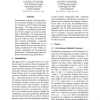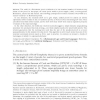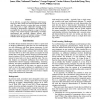229 search results - page 15 / 46 » Natural Language Proof Explanation |
COLING
2008
13 years 8 months ago
2008
Distributional measures of lexical similarity and kernel methods for classification are well-known tools in Natural Language Processing. We bring these two methods together by int...
CORR
2010
Springer
13 years 6 months ago
2010
Springer
Dependently typed -calculi such as the Logical Framework (LF) are capable of representing relationships between terms through types. By exploiting the "formulas-as-types"...
STOC
1999
ACM
13 years 11 months ago
1999
ACM
The width of a Resolution proof is defined to be the maximal number of literals in any clause of the proof. In this paper, we relate proof width to proof length (ϭsize), in both g...
JSYML
2010
13 years 5 months ago
2010
Continuous first-order logic has found interest among model theorists who wish to extend the classical analysis of “algebraic” structures (such as fields, group, and graphs) ...
AAAI
2007
13 years 9 months ago
2007
To be effective, an agent that collaborates with humans needs to be able to learn new tasks from humans they work with. This paper describes a system that learns executable task m...



